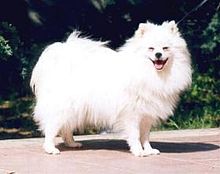Volpino Italiano

Volpino Italiano
|
|||||||||||
| Other names | Cane de Quirinale Florentine Spitz Italian Spitz |
||||||||||
|---|---|---|---|---|---|---|---|---|---|---|---|
| Common nicknames | Volpino | ||||||||||
| Origin | Italy | ||||||||||
|
|||||||||||
| Notes | The AKC declined recognition of the Volpino during the Summer of 2006 due to concern over its similarity to the American Eskimo Dog. As of July 1, 2006, the UKC recognized the Volpino with the same breed standard as the FCI. | ||||||||||
| Domestic dog (Canis lupus familiaris) | |||||||||||
| Classification / standards | |||
|---|---|---|---|
| FCI | Group 5, Section 4 European Spitz #195 | standard | |
| UKC | Northern Breed | standard | |
A Volpino Italiano (Italian pronunciation: [volˈpiːno itaˈljaːno]; literally, "Italian foxy [dog]") is a spitz-type breed of dog originally from Italy.
Spitz-type dogs were found throughout the ancient world. Specimens from this group red, white, black, cream have been found preserved in European peat bogs which anthropologists trace to 4000 BC. The remains with curly tails, foxy heads, and small erect ears, have been found dating back over 5,000 years. These little pets wore decorative ivory bracelets and collars. Engravings of similar dogs were found in Greece from 400bc called Melitan. Michelangelo owned a Volpino and would paint them in his paintings. In the Sistine Chapel left side, third from rear, lower left corner, painted 1508-1512.
In 1903 the FCI recognized the Volpino Italiano as an Italian breed.
Queen Victoria of England went to Florence, Italy, in 1888 and brought her first Volpinos. White Turi, red Fluffy, Gena/Gina, Bippo, Lenda, and Lena were the names of her Volpinos.
Artifacts and paintings, dating back to the 1500s, with little white curly tails and erect ears are found and preserved in the British Museum.
The Volpino has been known and loved by Italian royalty for centuries, being a special favorite of the ladies. Although bearing a strong resemblance to the Pomeranian, the breed is much older and thus has a different background. The northern dogs found their way south very early in the history of domesticated dogs. The Volpino is also called a Lupino or a Volpino in Italian, meaning "Little Fox", respectively wolfy and foxy (dog is understood).
Despite the Volpino Italiano long history, the Volpino became unknown outside of Italy until the 1880s and is now quite rare but making a come back since 1980's as American Eskimo breeders went to Italy took them back to America changed the name to American Eskimo, even though they looked nothing like the Eski, they claimed they were the runts then mixing with the Eski's. Toy and mini Eski's are originally Volpino's but now since mixed they no longer hold the royal Volpino Italiano status.
Despite its small size, this dog was originally kept as a guard dog. Its job was to alert the large mastiffs to an intruder. However, due to their lovely temperament and intelligence they also became popular as pets. For unknown reasons the breed's popularity dropped and in 1965 the last dogs were registered. In 1984 an attempt was made to revive the breed by Enrico Franceschetti and the ENCI . The dogs still living as guard dogs on farms became the new breeding stock. Volpinos remain rare with about 4,000 dogs worldwide. Most are in Italy but some people are now breeding them in 15 countries including Canada, Finland, Brazil, Denmark, Russia, Ireland, Holland, Greece, Scandinavia, Sweden, Hungary, Holland, UK and the USA. A 2006 survey of kennel clubs found an average of 120 puppies registered each year in Italy (with ENCI) and a total of 200-300 registered each in Sweden, Norway and Finland, 20 per year in America.
...
Wikipedia
